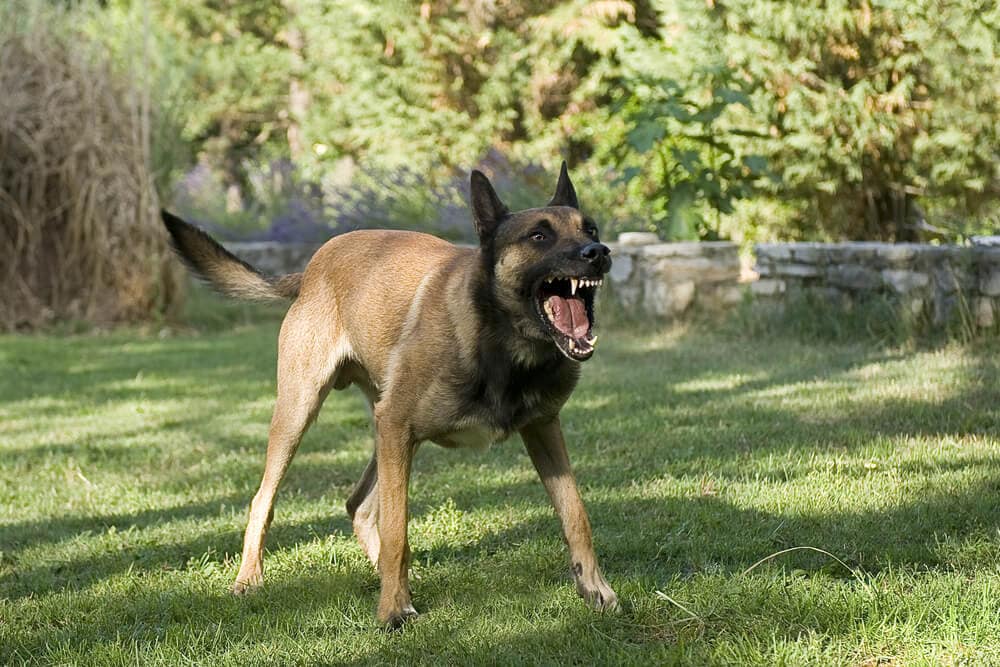Aggression in dogs can be a big problem for pet parents. It can be caused by many factors, including lack of socialization with other dogs, fear, illness, or it could even be an inherited genetic trait.
To help a dog with aggression, you should teach them how to behave, help them make friends with other dogs, ask a veterinarian to check if it’s feeling sick, or even get help from a dog training expert. Fixing this problem is important because it keeps everyone safe and makes life better for the dog.
What Is Aggression in Dogs?
Dog aggression refers to hostile behavior by a dog, which can include snapping, growling, barking menacingly, or even biting. This doesn’t mean they are bad, but it shows they’re struggling with something. This behavior can vary between dogs, some might display aggression frequently, while others might only show it when they’re frightened or anxious.
It’s crucial to note that fear and aggression, though linked, are not the same. A fearful dog might try to escape from the situation, whereas an aggressive dog may try to confront the perceived threat. However, in certain situations, fear can lead to aggression if the dog feels trapped and believes they must defend themselves.
Common Causes of Dog Aggression
Dog aggression can be caused by various factors, including lack of socialization, genetics, previous negative experiences, and immediate triggers in the environment. Here is a breakdown of each cause:
Lack of socialization
Lack of socialization can be a mild factor in some dogs showing aggression if they didn’t interact with other dogs during their puppyhood or if they get scared by loud noises or unfamiliar places.
Genetic predisposition
In some cases, genetic predisposition can be a deep-rooted factor in a dog’s aggressive behavior, especially if their parents displayed aggression or if they belong to a protective breed.
Previous negative experiences
Previous experiences can significantly influence a dog’s behavior. If a dog has had a frightening or painful experience in the past, they might be more likely to display aggression in similar situations later on. This is particularly true if the distressing event involved a specific person, type of animal, or context.
Environmental triggers
Dogs can also become aggressive due to certain immediate triggers in their environment, including guarding their food or toys or feeling overwhelmed in a crowd of people or animals. Each dog is unique, and a trigger for one dog might not affect another. Paying close attention to what upsets your dog can help you understand their needs better and find effective ways to manage their aggression.
Symptoms and Warning Signs of Dog Aggression
Dogs communicate their feelings through their behavior, and if we pay attention, we can notice the signs that they’re starting to feel uncomfortable or threatened. These symptoms and warning signs can range from subtle changes in behavior to more severe actions.
Here are some common warning signs of canine aggression to be aware of:
- Avoiding eye contact: This is an early sign, indicating that the dog might be feeling uncomfortable or stressed.
- Excessive yawning: When dogs are anxious or uneasy, they may yawn more than usual, which is a stress indicator.
- Lip licking: Dogs often try to calm themselves by repeatedly licking their lips.
- Dilated pupils or showing whites of eyes: When scared, their pupils may dilate and they will often open their eyes very wide showing the whites of their eyes, giving them a startled appearance.
- Growling: When a dog feels threatened or upset, they may growl as a warning sign, asking for the stressful situation to stop.
- Intense Staring: An intense and prolonged stare, particularly with a stiff posture or other aggressive signs, might indicate the dog feels threatened.
- Aggressive barking: Different from regular barking, aggressive barking often sounds deeper and more forceful, signaling the dog may feel threatened.
- Snarling: Snarling, a combination of growling and showing teeth, is a more serious warning that indicates the dog feels scared or angry.
- Lunging: This is when a dog moves at someone or something quickly and suddenly, usually while showing other signs of aggression like growling or snarling.
- Snapping: When a dog quickly opens and closes their mouth, as if to bite but without making contact, it’s a sign that they’re feeling extremely threatened.
- Biting: The most severe sign of aggression is when a dog actually bites. This signals that the dog feels threatened and is trying to defend themselves.
Types of Dog Aggression
Dog aggression can take different forms, including territorial, possessive, predatory, fear or anxiety-related aggression, and more. Understanding these types can help address the underlying causes and promote a safer and more harmonious relationship with your dog.
Here is each type of dog aggression further explained:
- Territorial aggression: This happens when dogs feel like their space is being invaded.
- Possessive aggression: Dogs display this type of aggression when they get upset because someone is trying to take something they see as theirs.
- Maternal aggression: This is seen in mother dogs protecting their puppies.
- Pain-related aggression: Dogs can show aggression if they’re hurt and someone touches the sore spot.
- Predatory aggression: This is when dogs act on their hunting instincts, which might be directed at smaller animals.
- Frustration aggression: Dogs may display aggression if they’re held back from something they want.
- Social conflict-related aggression: This occurs when dogs experience inner turmoil and react aggressively during their interactions with people or animals.
- Sexual aggression: This is displayed when dogs, typically unneutered males, show aggression towards other dogs in competition for a mate.
- Disease-related aggression: This can occur if dogs feel sick and the illness affects their behavior.
- Fear or anxiety-related aggression: Dogs may act out because they’re scared or anxious.
When to Be Concerned
Aggression in dogs is a serious concern, especially if it becomes frequent or severe, posing risks to people and other animals. Watch closely for aggressive behaviors like growling, snapping, or biting, even if not directed at a person, as they may indicate discomfort or fear in your dog.
Pay attention if your dog’s behavior suddenly changes, such as becoming avoidant or showing signs of aggression, especially if they were previously friendly.
When you notice these signs, it’s advisable to consult a vet to understand the underlying cause and receive guidance on how to help your dog. Timely intervention and support can lead to positive behavioral changes and better well-being for your furry friend.
Treatment for Dog Aggression
Treatment for dog aggression involves a comprehensive evaluation of the dog’s history, behaviors, and triggers, alongside a physical exam and diagnostics by a veterinarian or dog behaviorist to understand the root cause.
The treatment plan can involve a combination of medications, environmental adjustments, and behavioral training. Medications can help manage underlying issues like anxiety, while creating a stress-free environment or a safe space can make the dog more at ease.
Behavioral training, teaching the dog to respond differently to triggers and rewarding calm behavior, is a key component. While aggression can often be reduced, it might not be completely “cured” by patience and consistent effort. Most dogs can learn to manage their aggression with time and the right strategies.
Prevention and Management of Canine Aggression
To prevent and manage dog aggression, understanding your dog’s behavior and needs is key. Early socialization and consistent, positive reinforcement-based training from puppyhood can help prevent many cases of aggression.
Creating a calm and secure environment while respecting your dog’s boundaries is crucial. Be mindful of potential triggers for aggression and avoid them whenever possible. Before adopting a dog, research their breed to ensure they fit well with your home environment and lifestyle.
If your dog is showing signs of aggression, it’s essential to manage their behavior proactively, such as by diverting their attention or creating distance between them and the trigger. Remember, managing aggression is about creating a safe and comfortable environment for your dog, not about punishing them for their natural responses.
Conclusion
In short, dog aggression can appear in different ways and for different reasons. We can help our dogs by spotting the signs early, understanding what’s causing the problem, and getting help when we need it. Even though it might take some time, most dogs can learn to calm their aggression with the right support.
If you’re worried about your dog, talking to a veterinarian or dog behaviorist is a good idea. They’re there to help you and your dog figure things out.
Frequently Asked Questions
At what age do dogs become aggressive?
While dogs can show signs of aggression at any age, behavior issues like aggression often start to appear as a dog reaches social maturity, typically between 1 to 3 years old. However, it can vary greatly depending on the individual dog and breed.
Can dog aggression be fixed?
While dog aggression can often be managed and significantly reduced with the right strategies like behavioral training and, in some cases, medication, it might not be completely “cured”. Each dog and situation is unique, so professional guidance is important.
What to do if your dog snaps at you?
If your dog snaps at you, staying calm and giving them space is important. Avoid punishing them, as this could escalate the situation. Instead, consult a professional dog behaviorist or veterinarian to understand and address the issue.
Is there medication for aggressive dogs?
Yes, in some cases, veterinarians may prescribe medication to help manage aggression in dogs, especially if it’s related to conditions like anxiety. However, medication is usually used alongside behavioral training and other management strategies.





